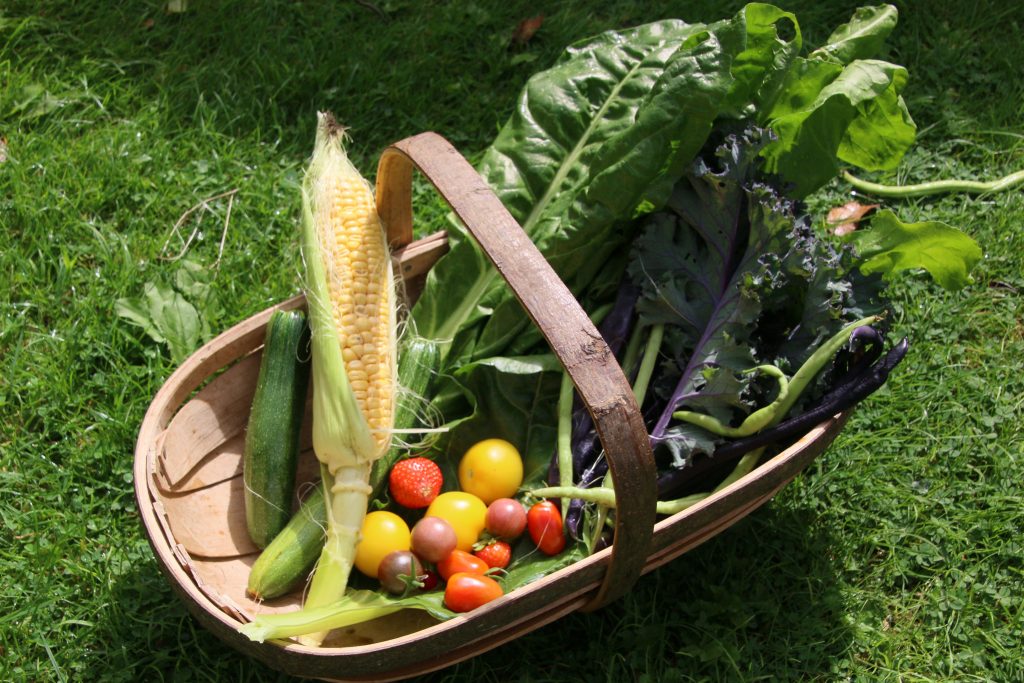This post is the third in the ‘Grow Your Own Nutrition’ series. In this series, I’m looking at ways to grow useful amounts of fruit and vegetables on a small vegetable plot, around 20 square meters. In Grow Your Own Nutrition 3, I’m considering the annual crops you can plant and grow. That means plants that grow, produce a crop, then die, all within one year. I’ll be talking about things you can grow in a greenhouse too if you’re lucky enough to have one.
Annual Crops
For annual crops, there are many possibilities. I’ll list here the ones that I’ve grown, to give an idea of what’s possible in the size of the plot I’ve described.
Autumn Sowing
Black Kale and Spring Cabbage
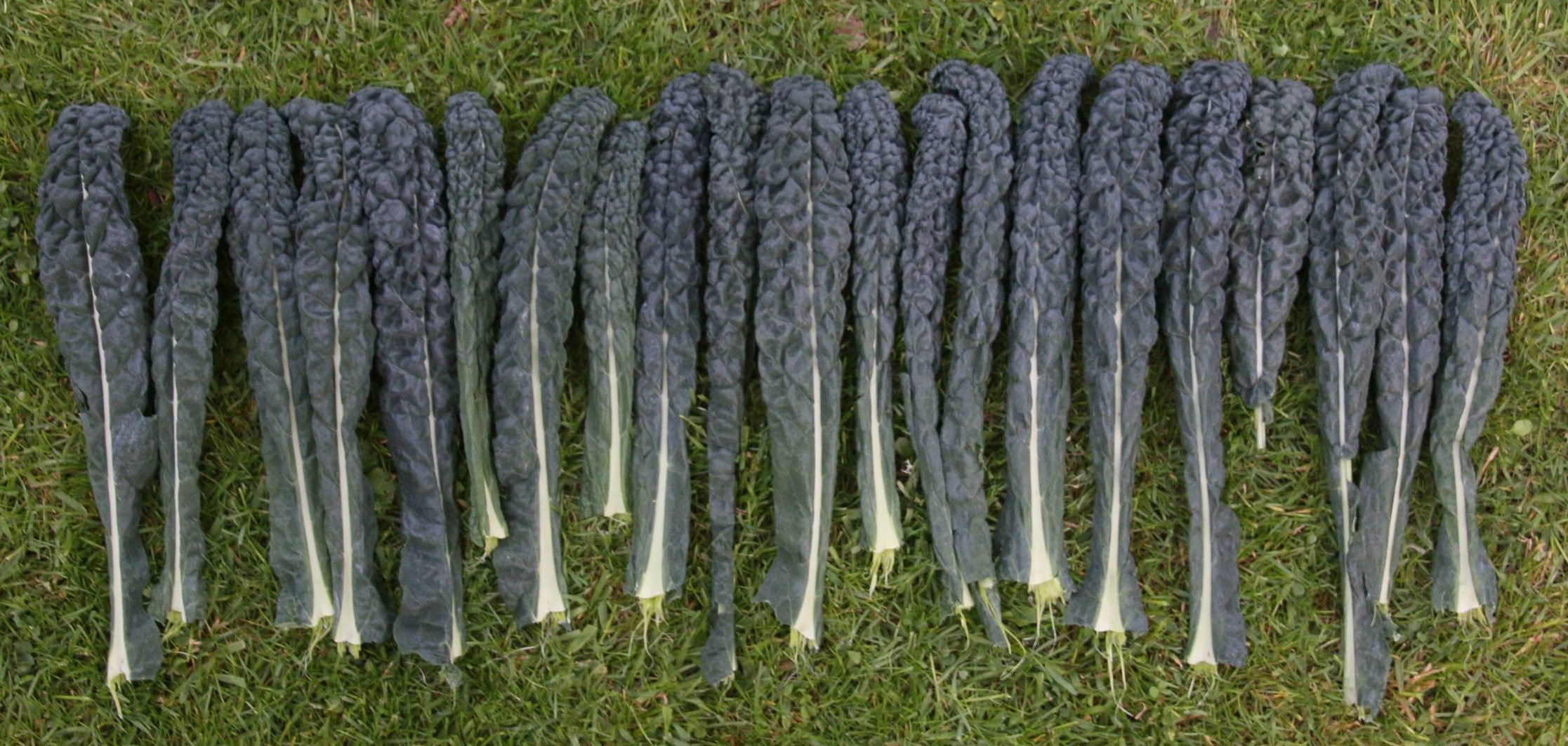 For crops planted outside, the possibilities are almost endless. But different crops need sowing at different times of the year. Let’s start with Autumn. Autumn sowings of spring cabbage and Italian black kale are worthwhile, to give an early crop from April onwards. You’ll need to protect them from pigeons and cabbage white butterflies with a simple mesh cage. To make cages, construct a frame from bamboo canes, and cover it with panels of half-inch plastic mesh. You can reuse this many times.
For crops planted outside, the possibilities are almost endless. But different crops need sowing at different times of the year. Let’s start with Autumn. Autumn sowings of spring cabbage and Italian black kale are worthwhile, to give an early crop from April onwards. You’ll need to protect them from pigeons and cabbage white butterflies with a simple mesh cage. To make cages, construct a frame from bamboo canes, and cover it with panels of half-inch plastic mesh. You can reuse this many times.
Aphid problems
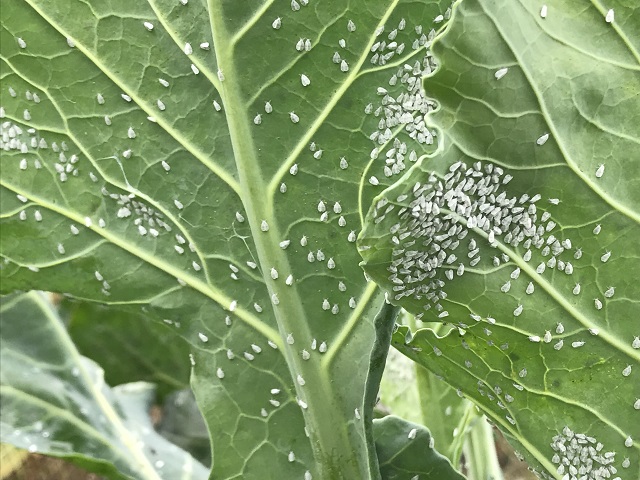 The big advantage of spring cabbage and kale is that they won’t be affected by whitefly. Brassica whitefly is a type of aphid. They have become a serious problem in recent years, with climate change. But crops planted in Autumn are less affected because the whitefly is usually killed off over Winter. They don’t reappear till late Summer, so won’t be a problem when you harvest. There’s pretty much no way to control whitefly. Even using relatively benign pesticides such as pyrethrin doesn’t work. They just fly away and come back again.
The big advantage of spring cabbage and kale is that they won’t be affected by whitefly. Brassica whitefly is a type of aphid. They have become a serious problem in recent years, with climate change. But crops planted in Autumn are less affected because the whitefly is usually killed off over Winter. They don’t reappear till late Summer, so won’t be a problem when you harvest. There’s pretty much no way to control whitefly. Even using relatively benign pesticides such as pyrethrin doesn’t work. They just fly away and come back again.
I have tried covering crops with supposedly whitefly-proof mesh, but that was a disaster. There will always be a gap in the mesh weave somewhere for one or two to get in. They then multiply inside the mesh, and you end up with a huge infestation inside the whitefly-proof mesh because they can’t get out! Mostly, you just have to put up with them. Or stop planting brassicas that need harvesting in late Summer and Autumn.
Broad Beans
 I have bad memories of broad beans, from school dinners. Reconstituted from dried beans and cooked for hours, they were disgusting. But fresh broad beans from the garden are completely different, and delicious. This is another good crop to plant in Autumn for harvesting in Spring. They will probably need protecting over Winter with a mini-polytunnel, but if you choose the dwarf varieties, that’s cheap and easy to do. They can be affected by blackflies, particularly if they’re in a polytunnel. Blackflies (like greenflies) are another type of aphid. But the stage of their life cycle that does the most damage doesn’t fly, so are more susceptible to spraying with an organic insecticide. It also means they’re more susceptible to predation by ladybirds and hoverflies. This is by far the best method of control.
I have bad memories of broad beans, from school dinners. Reconstituted from dried beans and cooked for hours, they were disgusting. But fresh broad beans from the garden are completely different, and delicious. This is another good crop to plant in Autumn for harvesting in Spring. They will probably need protecting over Winter with a mini-polytunnel, but if you choose the dwarf varieties, that’s cheap and easy to do. They can be affected by blackflies, particularly if they’re in a polytunnel. Blackflies (like greenflies) are another type of aphid. But the stage of their life cycle that does the most damage doesn’t fly, so are more susceptible to spraying with an organic insecticide. It also means they’re more susceptible to predation by ladybirds and hoverflies. This is by far the best method of control.
Potatoes
 In March, you’ll probably want to think about getting potatoes in. Potatoes are a tricky one on a small veg plot because they take up a lot of space to get a decent crop. And they’re cheap and plentiful at the greengrocer. So grow something unusual, that you can’t get in the shops. They are categorised as ‘early’, ‘mid’, and ‘late’ seasons, but I wouldn’t bother too much about that. Far more important is whether they’re blight resistant.
In March, you’ll probably want to think about getting potatoes in. Potatoes are a tricky one on a small veg plot because they take up a lot of space to get a decent crop. And they’re cheap and plentiful at the greengrocer. So grow something unusual, that you can’t get in the shops. They are categorised as ‘early’, ‘mid’, and ‘late’ seasons, but I wouldn’t bother too much about that. Far more important is whether they’re blight resistant.
As potatoes and tomatoes are closely related, they both suffer from the same blight problems. So always choose a blight-resistant variety. The Sarpo varieties are particularly good for blight resistance. I’ve also been growing one called Blue Annelise (see picture), which ticks the boxes for being both blight resistant and unusual. It’s a deep blue colour (the flesh as well as the skin). It tastes good too. Pink Fir Apple is probably my favourite for taste, but I’ve given up on that. Although the tubers are blight resistant, the plants aren’t, so die back before much of a crop has formed. If you live in the south of the UK, don’t bother with potatoes that aren’t fully blight resistant, you’ll only be disappointed.
Spring Sowing
Peas
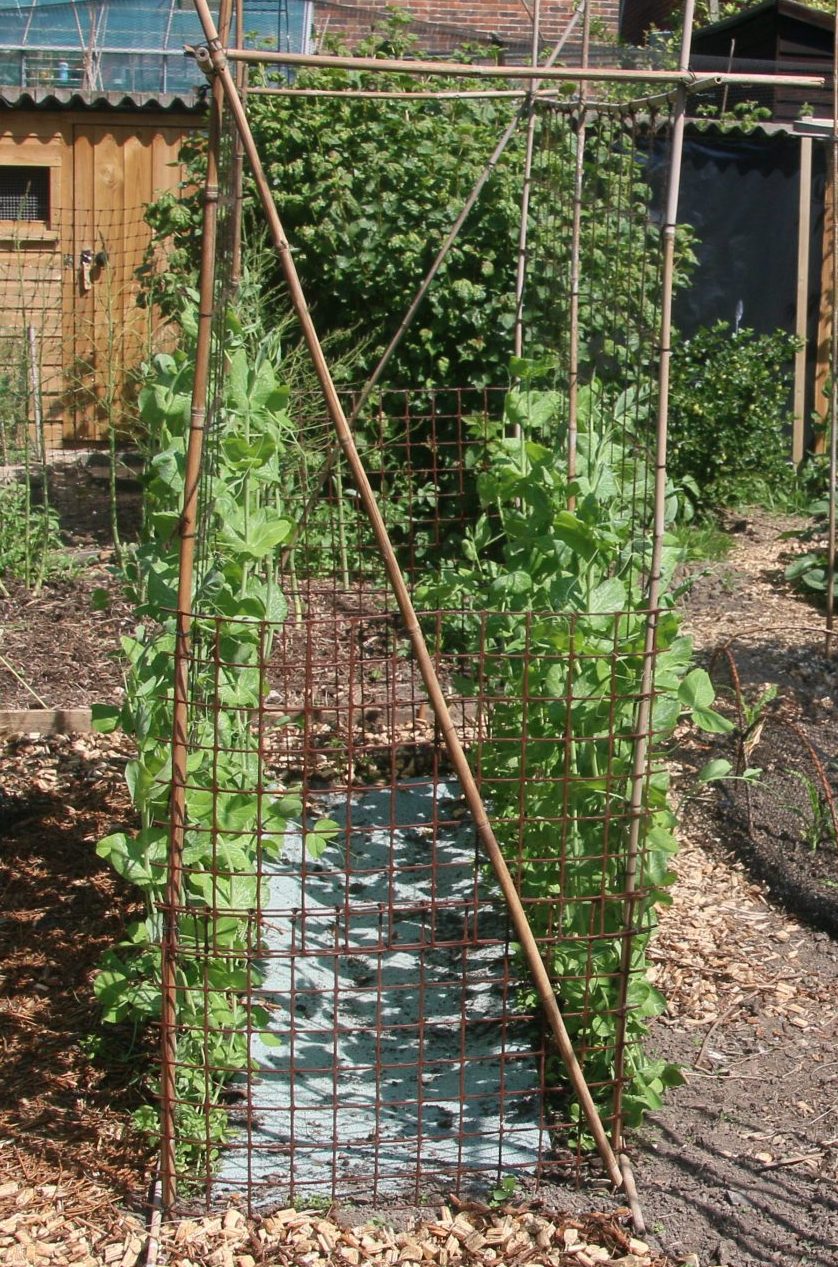 In Spring, the first crop I always plant is peas. There is nothing quite like fresh peas from the garden. Choose a variety that’s a good cropper but doesn’t grow too tall. They’ll need something to cling to and climb up. I use natural fibre netting (readily available online), strung between bamboo canes. Make sure the netting is well supported, and the bamboo frame is braced against the wind. The pea plants are quite heavy, and the whole structure can blow over easily. The plastic mesh at the end shown in the picture is optional. I use it to stop our cats playing in the there when the plants are small, and wrecking them!
In Spring, the first crop I always plant is peas. There is nothing quite like fresh peas from the garden. Choose a variety that’s a good cropper but doesn’t grow too tall. They’ll need something to cling to and climb up. I use natural fibre netting (readily available online), strung between bamboo canes. Make sure the netting is well supported, and the bamboo frame is braced against the wind. The pea plants are quite heavy, and the whole structure can blow over easily. The plastic mesh at the end shown in the picture is optional. I use it to stop our cats playing in the there when the plants are small, and wrecking them!
Soak the pea seeds for 24 hours before you plant them. And if you can, germinate them indoors or somewhere where mice can’t get them – mice love peas! I germinate them in compost-filled plastic guttering in the greenhouse, but you could use pots of compost. Use a lot of them. Germination rates are often low, particularly if you’re planting outdoors where the mice can get them. Again, you can use carpet between the rows to keep down weeds.
Apart from being more sustainable, using natural netting means you don’t have to disentangle the peas from the net when they’re finished. You can just cut down the net, and put the whole lot in the compost. One other tip though. Leave the roots of the peas in the the soil. They contain nitrogen-fixing bacteria, which improve soil fertility.
Brussels Sprouts
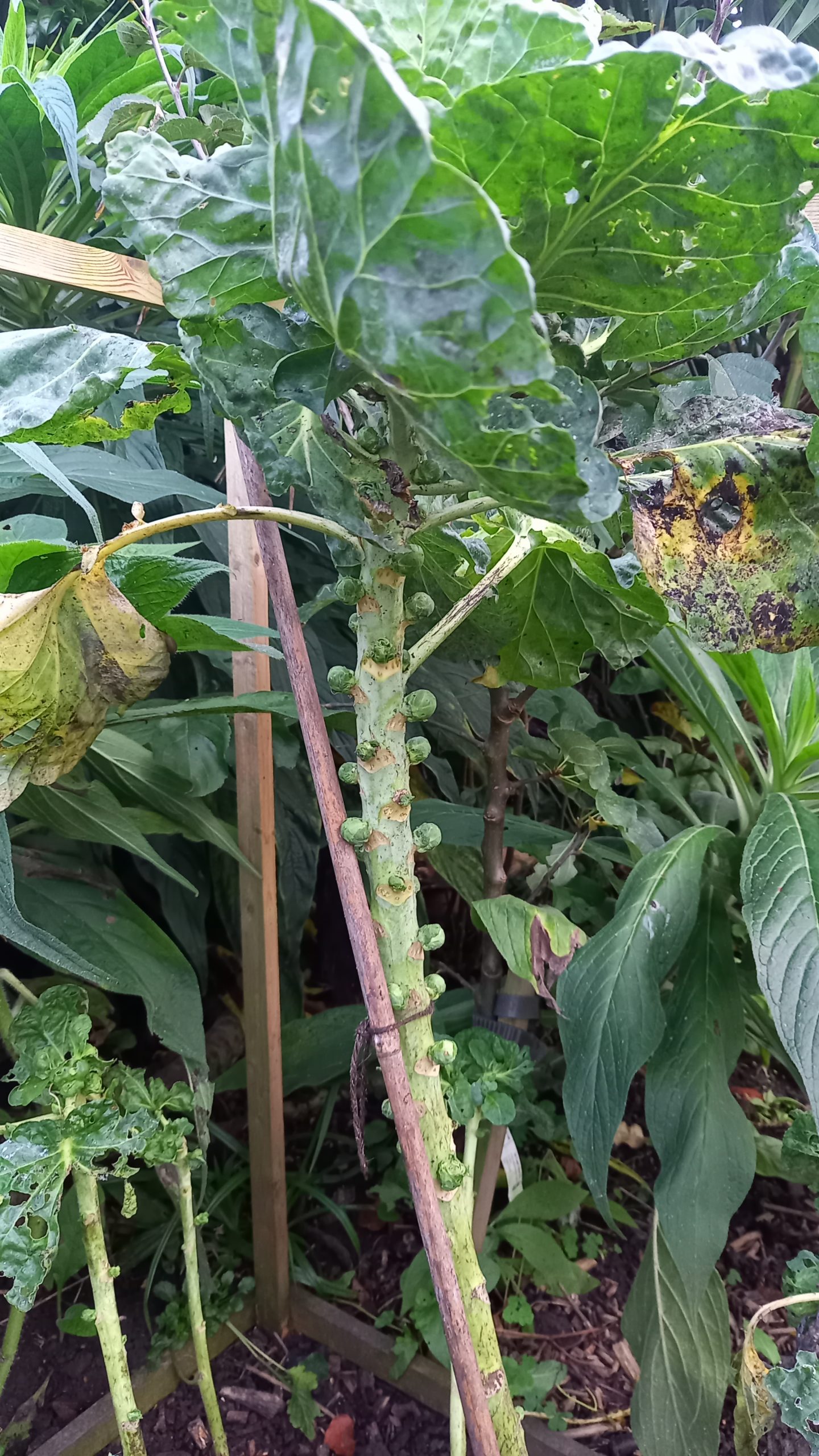 In April, I plant brussels sprouts too, for a Christmas harvest. Not everyone’s favourite, but if you choose a sweet, non-bitter variety such as Brodie, they’re delicious. They’re nothing like sprouts from the supermarket. They’ll need protection from pigeons and cabbage white butterflies again, and they will get infested with whitefly. If this happens, squirt them with a hose to disperse the whitefly every couple of days, and to wash off the honeydew from the whitefly larvae. Do it carefully though, the leaves are very brittle. The honeydew causes sooty moulds to grow. Although these don’t harm the plant directly, they can stop light from getting to the leaf. This could mean the leaf will die. By the time Christmas comes though, you’ll have sweet, tasty sprouts, and the whitefly should have gone.
In April, I plant brussels sprouts too, for a Christmas harvest. Not everyone’s favourite, but if you choose a sweet, non-bitter variety such as Brodie, they’re delicious. They’re nothing like sprouts from the supermarket. They’ll need protection from pigeons and cabbage white butterflies again, and they will get infested with whitefly. If this happens, squirt them with a hose to disperse the whitefly every couple of days, and to wash off the honeydew from the whitefly larvae. Do it carefully though, the leaves are very brittle. The honeydew causes sooty moulds to grow. Although these don’t harm the plant directly, they can stop light from getting to the leaf. This could mean the leaf will die. By the time Christmas comes though, you’ll have sweet, tasty sprouts, and the whitefly should have gone.
Courgettes and Sweetcorn
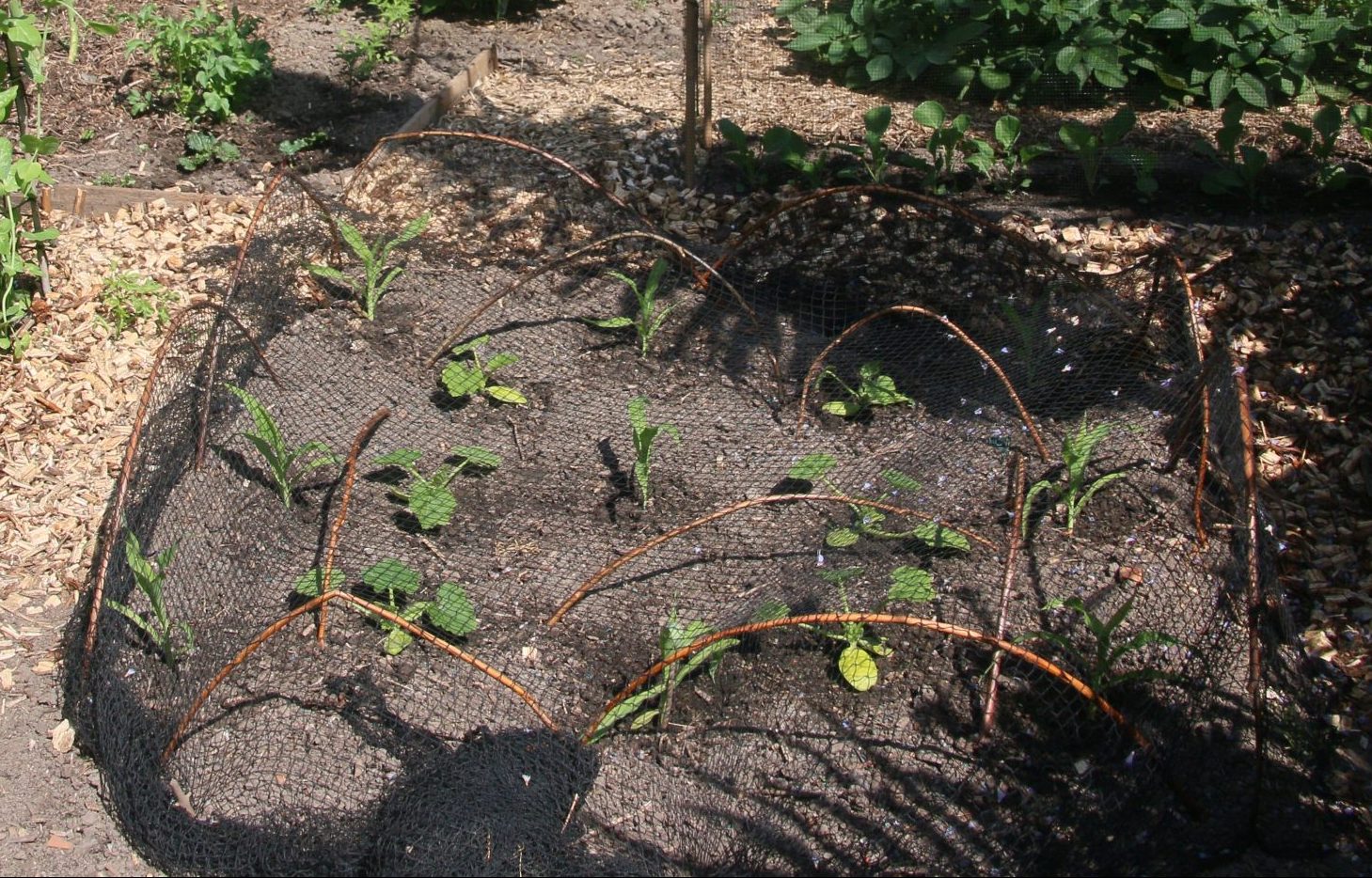 From now, the key to maximizing the yield from your plot is succession planting. By the time the cabbage and kale are over, I reuse the space to plant sweetcorn and courgettes. These two crops are ideal for a small plot, as you can grow them in the same space. The courgettes grow close to the ground, the sweetcorn grows up through them. It’s best to germinate both courgettes and sweetcorn in three-inch pots on an indoor windowsill. Then plant them out as small plants (they’ll grow quickly) in late May.
From now, the key to maximizing the yield from your plot is succession planting. By the time the cabbage and kale are over, I reuse the space to plant sweetcorn and courgettes. These two crops are ideal for a small plot, as you can grow them in the same space. The courgettes grow close to the ground, the sweetcorn grows up through them. It’s best to germinate both courgettes and sweetcorn in three-inch pots on an indoor windowsill. Then plant them out as small plants (they’ll grow quickly) in late May.
Courgettes
These crops are also good as they don’t suffer much from pests and diseases, so don’t need protection. In some years, the courgettes will produce a huge crop very quickly, you’ll be wondering what to do with them all. But make sure you pick them all while they’re still courgette-sized. Let them grow to the marrow, and the plants will stop producing more courgettes. Courgettes and marrows are the same plants. Varieties that taste better when they’re small are sold as courgettes and those that are better when larger are sold as marrows.
Sweetcorn
Plant the sweetcorn in a square (I use nine plants, three rows of three). This helps with germination, as sweetcorn is wind-pollinated. You’ll get two cobs from each plant in a good year, so it’s not a big crop. But the taste of sweetcorn freshly harvested is magnificent, They’re so much better than shop-bought ones.
Climbing Beans
 In late May, I sow climbing beans, usually in pots in the greenhouse to get them started quickly. I’m not keen on runner beans, preferring the climbing French beans. They’re more colourful, with yellow and purple varieties, and they taste better, in my view. I grow them up tall canes (2.4m ones), in two angled rows, leaning into each other with a cane along the top at the crossing point of the uprights.
In late May, I sow climbing beans, usually in pots in the greenhouse to get them started quickly. I’m not keen on runner beans, preferring the climbing French beans. They’re more colourful, with yellow and purple varieties, and they taste better, in my view. I grow them up tall canes (2.4m ones), in two angled rows, leaning into each other with a cane along the top at the crossing point of the uprights.
Tie this horizontal cane into each of the pairs of vertical canes tightly, and you’ll have a strong, wind-resistant structure. You can plant two plants on each cane. But they’ll need a bit of help climbing up the right ones. For some reason, left to their own devices, you always seem to end up with half a dozen plants all going up the same cane! These will start cropping around late July and you’ll get plenty of beans right through September.
Greenhouse crops
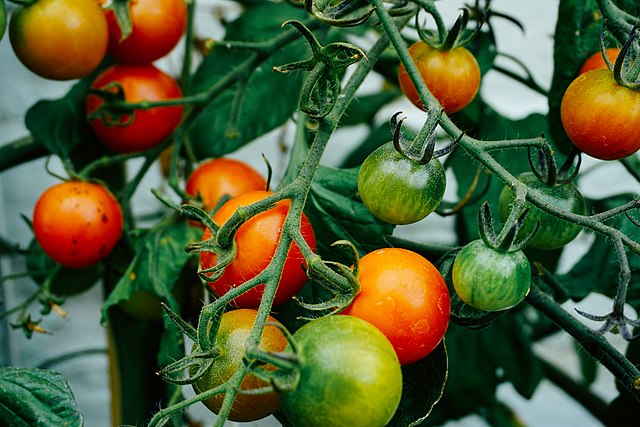 If you have a greenhouse, that opens up the possibilities further. Tomatoes are the obvious greenhouse crop. In a greenhouse, they grow more vigorously, thriving in higher temperatures. But they’re also less likely to succumb to blight. Nowadays, tomato blight affects almost all outdoor-grown crops, unless you grow blight-resistant varieties. But although there are some excellent blight-resistant potato varieties, the same cannot be said for tomatoes. Most blight-resistant tomatoes taste awful.
If you have a greenhouse, that opens up the possibilities further. Tomatoes are the obvious greenhouse crop. In a greenhouse, they grow more vigorously, thriving in higher temperatures. But they’re also less likely to succumb to blight. Nowadays, tomato blight affects almost all outdoor-grown crops, unless you grow blight-resistant varieties. But although there are some excellent blight-resistant potato varieties, the same cannot be said for tomatoes. Most blight-resistant tomatoes taste awful.
Chilli peppers are good in a greenhouse too. They mostly grow on small plants you can keep in pots. If you grow the super-hot varieties, a couple of plants will produce enough chillies to last you all year.
Other good crops under glass include cucamelons (not to everyone’s taste, but I love them), cape gooseberries (physalis), and even watermelons, in a good Summer. You can also grow cucumbers, aubergines, sweet peppers, and even some of the more exotic fruits, but yields of these are often low.
Summer Sowing
Kale and Chard
 Once Summer comes, it’s time to think about sowing for Autumn crops. There are two I plant: kale and chard. Of these, chard is by far the most satisfactory. It seems to suffer from no pests and diseases at all, even the pigeons don’t like it (well mine don’t), so it needs no protection. Maybe the odd slug and snail, but that’s about all. I use old strips of carpet on either side of the row of chard plants, which keeps competing weeds at bay and discourages slugs and snails. You can do that between rows of vegetables. It’s particularly good between rows of tall crops such as peas and beans, where weeding can otherwise be difficult.
Once Summer comes, it’s time to think about sowing for Autumn crops. There are two I plant: kale and chard. Of these, chard is by far the most satisfactory. It seems to suffer from no pests and diseases at all, even the pigeons don’t like it (well mine don’t), so it needs no protection. Maybe the odd slug and snail, but that’s about all. I use old strips of carpet on either side of the row of chard plants, which keeps competing weeds at bay and discourages slugs and snails. You can do that between rows of vegetables. It’s particularly good between rows of tall crops such as peas and beans, where weeding can otherwise be difficult.
Grow a chard variety such as ‘Swiss Lights’. It will look spectacular too, a real splash of colour in the Winter garden. It’s ‘cut and come again’ too, so you can pull leaves off it rather than harvesting the whole plant, and it will regrow right through the Winter. In Spring, it will ‘bolt’ (produce a flowering stem), but you’ll have had a decent crop off it by then. Remember when cooking chard that the stems take much longer to cook than the leaves. So bung those in the pan five minutes earlier.
There’s so much more …
I haven’t mentioned root vegetables, apart from potatoes, because they take up quite a bit of space in a small plot. One carrot plant provides one carrot, no more. Having said that, I have grown carrots in an old fridge with the door removed, laid on its back, with holes drilled through the back for drainage. Only do this if it doesn’t contain CFCs that might leak out. Raising the carrots like this prevents carrot fly, which flies along close to the ground. Again, I’ve chosen interesting varieties, particularly ones that are a colour other than orange. Scorzonera is fun and tasty too, and you can’t buy them in the shops.
You could also consider salad crops. They’re mostly easy and quick to grow. Lettuces, pak choi, rocket, and Erba Stella are all things I’ve tried, but with varying success. Traditional salad crops are slug magnets. Others, well, just aren’t exciting enough, somehow. But if you love salads, give them a go. Radishes are great too because they grow from planting to harvesting in just six weeks. For a more unusual choice, try the ones where you eat the seed pods rather than the root.
Related posts:
– Grow Your Own Nutrition part 1
– Grow Your Own Nutrition part 2
In Conclusion
There is much, much more you can grow, of course, particularly annual crops. But the ones I’ve mentioned here are the ones I’ve had the most success with. But it does, in the end, all depend on the taste. As ever, grow what you like to eat, especially if you can’t get it in the shops. But even if you can, it’s much cheaper to grow your own, and it will always taste so much better!
In these three articles, I’ve tried to give you a flavour of how you can grow plentiful fruit and vegetables, to keep you supplied for most of the year. But you need to plan your successions carefully and make sure you plant crops that maximise your yields. Good luck!
